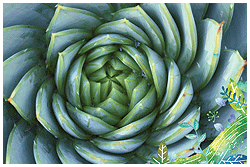
People
may sometimes find symmetrically perfect patterns from some plants.
They may think that the patterns are similar to those created by
artists. Galileo Galilei, one of the greatest physicists and mathematicians
in history, wrote in his book Il Saggiatore, “[The universe] is
written in the language of mathematics.” To better understand that
language in nature, there have been many studies and long-term observations.
Scientists’ explanation for the intriguing patterns in plants is
the Fibonacci sequence. It is a mathematical term, which can be
used to describe how things grow by accumulating and multiplying
based on what was already created. Plants with Fibonacci patterns
grow in spirals, either in a clockwise direction or the opposite.
According to Professor Nikhat Parveen at University of Georgia in
the United States, the Fibonacci arrangement provides the best physical
accommodation of a plant’s seeds or branches, maximizing their exposure
to the sun.
Try to find some plants that perfectly demonstrate the Fibonacci
sequence. Those include sunflowers, succulents, and flowers like
jeweled carpets.